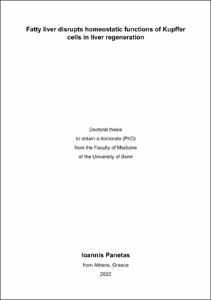Panetas, Ioannis: Fatty liver disrupts homeostatic functions of Kupffer cells in liver regeneration. - Bonn, 2022. - Dissertation, Rheinische Friedrich-Wilhelms-Universität Bonn.
Online-Ausgabe in bonndoc: https://nbn-resolving.org/urn:nbn:de:hbz:5-66316
Online-Ausgabe in bonndoc: https://nbn-resolving.org/urn:nbn:de:hbz:5-66316
@phdthesis{handle:20.500.11811/9762,
urn: https://nbn-resolving.org/urn:nbn:de:hbz:5-66316,
author = {{Ioannis Panetas}},
title = {Fatty liver disrupts homeostatic functions of Kupffer cells in liver regeneration},
school = {Rheinische Friedrich-Wilhelms-Universität Bonn},
year = 2022,
month = apr,
note = {Obesity-associated liver disease represents a continuously increasing health concern. Besides the risk of obese individuals towards liver dysfunction, cirrhosis and hepatocellular carcinoma, an increased risk for defective liver regeneration post hepatic resection contributes to post-operative morbidity and mortality. Failure of hepatic regeneration, which can ultimately lead to liver failure, is a result of impaired hepatic cell proliferation. Hepatic macrophages have multiple roles in the liver, both in homeostasis and disease progression. However, their exact role and kinetics during physiological and impaired liver regeneration, as seen with non-alcoholic fatty liver disease (NAFLD), is not well understood.
In this study, the role of macrophage progenies during liver regeneration was analyzed by using rodent models of diet-induced obesity followed by models of partial hepatectomy or toxin-induced liver injury.
In our set of experiments, obese mice appeared to have impaired liver regeneration and delayed resolution of inflammation after hepatectomy and acute liver injury, respectively. Macrophages in the fatty liver are among the most altered innate immune populations, with loss of Kupffer cells and recruitment of bone marrow-derived macrophages. Kupffer cells are important for survival and normal liver regeneration of the remnant liver post hepatectomy, while bone marrow-derived macrophages do not exhibit a significant role in this process.
Early post-operative intrahepatic gene expression of il-6 is impaired in obese mice, which followingly disrupts the expression of cell cycle genes associated with liver cell proliferation and regeneration. Proliferation of hepatocytes, LSECs and embryonic Kupffer cells is decreased post hepatectomy, which leads to a reduced liver regenerative capacity.
These results highlight the importance of embryonic Kupffer cells for liver regeneration through the production of IL-6, which drives a cascade proliferation of liver cells to restore the loss of liver tissue. Obesity strongly impairs the liver regeneration through loss of embryonic Kupffer cells and replenishment by bone marrow-derived macrophages which leads to a defective liver cell proliferation.},
url = {https://hdl.handle.net/20.500.11811/9762}
}
urn: https://nbn-resolving.org/urn:nbn:de:hbz:5-66316,
author = {{Ioannis Panetas}},
title = {Fatty liver disrupts homeostatic functions of Kupffer cells in liver regeneration},
school = {Rheinische Friedrich-Wilhelms-Universität Bonn},
year = 2022,
month = apr,
note = {Obesity-associated liver disease represents a continuously increasing health concern. Besides the risk of obese individuals towards liver dysfunction, cirrhosis and hepatocellular carcinoma, an increased risk for defective liver regeneration post hepatic resection contributes to post-operative morbidity and mortality. Failure of hepatic regeneration, which can ultimately lead to liver failure, is a result of impaired hepatic cell proliferation. Hepatic macrophages have multiple roles in the liver, both in homeostasis and disease progression. However, their exact role and kinetics during physiological and impaired liver regeneration, as seen with non-alcoholic fatty liver disease (NAFLD), is not well understood.
In this study, the role of macrophage progenies during liver regeneration was analyzed by using rodent models of diet-induced obesity followed by models of partial hepatectomy or toxin-induced liver injury.
In our set of experiments, obese mice appeared to have impaired liver regeneration and delayed resolution of inflammation after hepatectomy and acute liver injury, respectively. Macrophages in the fatty liver are among the most altered innate immune populations, with loss of Kupffer cells and recruitment of bone marrow-derived macrophages. Kupffer cells are important for survival and normal liver regeneration of the remnant liver post hepatectomy, while bone marrow-derived macrophages do not exhibit a significant role in this process.
Early post-operative intrahepatic gene expression of il-6 is impaired in obese mice, which followingly disrupts the expression of cell cycle genes associated with liver cell proliferation and regeneration. Proliferation of hepatocytes, LSECs and embryonic Kupffer cells is decreased post hepatectomy, which leads to a reduced liver regenerative capacity.
These results highlight the importance of embryonic Kupffer cells for liver regeneration through the production of IL-6, which drives a cascade proliferation of liver cells to restore the loss of liver tissue. Obesity strongly impairs the liver regeneration through loss of embryonic Kupffer cells and replenishment by bone marrow-derived macrophages which leads to a defective liver cell proliferation.},
url = {https://hdl.handle.net/20.500.11811/9762}
}






